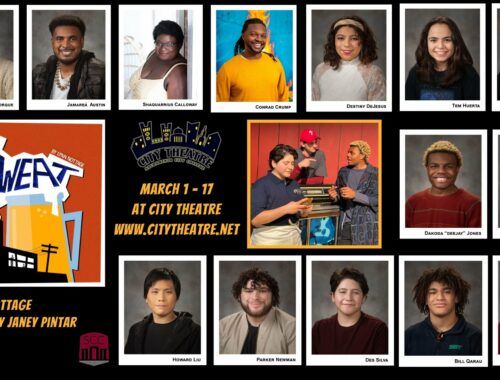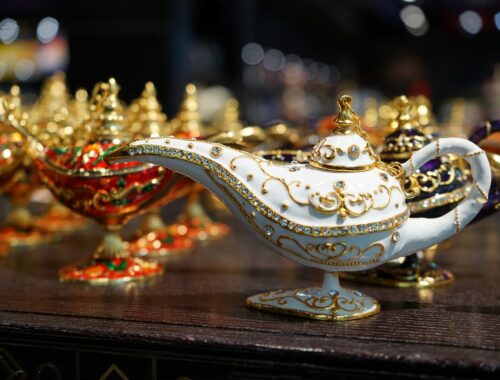
Auditions: Emilia
by Morgan Lloyd Malcolm, Directed by Lori Ann DeLappe-Grondin
When: Feb. 17, 2024 – 12:00 – 4:00 pm
Mar. 4 & 5, 7:00 – 10:00 pm
Where: The Art Court Theatre at Sacramento City College.
What: Auditions will consist of readings of sides from the Emilia script. You are encouraged to read the script before auditioning. It’s available on Amazon.
Note: In a significant reversal of the theatre of Shakespeare’s day, all characters in Emilia – male and female – must be played by female-identifying actors. The three actors playing Emilia are written for non-white actors.
‘Emilia has been written to be performed by a diverse cast of female-identifying actresses – diverse in terms of race, body shape, disability, sexuality,gender non-conformity and beyond! By its nature it challenges the traditional casting conventions of the theatre industry and wider society. It would not be the same play if this is ignored. Ifyou’reperforming the play where it is impossible to adhere to this diversity, then pleasecast against the “usualtype”. Bebold! The three Emilias in particular talk about feeling “other” and deal with issues of race and gender in equality – please keep this in mind when casting. What do these themes mean to you in your community? How can this play help you address the inequalities where you live? What does this play mean to yourcompany?Every production of this play will feel different because it will mean something different to each community. Embrace this. And enjoy it!’
~Morgan Lloyd Malcolm
For the auditions, please bring:
- Theatre/performance resume if you have one,
- Headshot if you have one, and
- Any conflicts you may have for the rehearsal and performance schedule.
Rehearsals: Begin Mar. 11. Days to be determined based on availability. We will have up to 5 rehearsals a week. Evening rehearsals will be 7:00 – 10:30 pm, Saturday 12:00 – 4:00 pm, Sundays, 6:00 – 9:00 pm. Base your conflicts on this.
Tech and Dress:
- Saturday, April 20 – 10:00 am – 8:00 pm, Tech
- Monday – Wednesday, April 22 – 24, 6:00 – 10:30 pm, Dress Rehearsal
- Thursday, April 25, 6:00 pm call, final dress/invited preview
- Wednesday, May 1, 7:00 pm
Performances: April 26 – May 11, 2024. Thur/Fri/Sat at 7:30 pm, Sun at 2:00 pm.
Additional Information:
Character breakdown & Doubling
| Actor # | Charcters Played |
|---|---|
| Actor 1 | Emilia1 |
| Actor 2 | Emilia2 |
| Actor 3 | Emilia3 |
| Actor 4 | Margaret Johnson |
| Mary Sidney | |
| Hester | |
| Actor 5 | Susan Bertie |
| Mary | |
| Bob | |
| Actor 6 | Lady Helena |
| Lord Howard | |
| Eve | |
| Actor 7 | Lady Cordelia |
| Flora | |
| Actor 8 | Lady Katherine |
| Desdemona (Othello) | |
| Actor 9 | Lord Thomas Howard |
| Judith | |
| Priest | |
| Actor 10 | Lord Collins |
| Lady Anne | |
| Dave | |
| Actor 11 | Lord Alphonso Lanier |
| Emilia (Othello) | |
| Actor 12 | William Shakespeare |
| Man 2 | |
| Actor 13 | Lady Margaret Clifford |
| Midwife | |
| Man 1 | |
| Actors 14, 15 | Muses |
Character descriptions (Historical characters only)
Margaret Johnson (1554?–1587) and Baptista Bassano (1515/1520?–1576)
Baptista Bassano was one of six sons born to Jeronimo Bassano. The Bassano family were court musicians and instrument makers who immigrated to England from Venice in the 1530s to play in the court of King Henry VIII. Little is known about Margaret Johnson, with whom Baptista had two children, Aemilia and Angela. Baptista’s will dated 1576 describes Margaret as his ‘reputed wife’ to whom he leaves the leases for three houses in St. Botolph, Bishopsgate, where the family resided. Both Margaret and Baptista were buried at St. Botolph’s, Bishopsgate, just outside of London.
Susan Bertie Grey Wingfield, Countess of Kent (1554–after 1596)
Catherine Willoughby, Duchess of Suffolk, and her second husband Richard Bertie, fled with their family to the continent soon after their daughter Susan’s birth to escape Protestant persecution. Upon their return in 1559, Susan was educated along with her siblings by the reformer Miles Coverdale. In 1570, Susan married Reynold Grey, later Earl of Kent, who passed away in 1573. In 1581, she married Sir John Wingfield. It was during this time that Aemilia Lanyer received a humanist education under Susan’s guidance; Aemilia later honoured Susan in a dedicatory poem in Salve Deus Rex Judaeorum (1611). In 1596, Sir John Wingfield died in battle at Cadiz, leaving his widow heavily in debt; Elizabeth I granted Susan an annual pension of £100.
Katherine Knyvett Rich Howard, Countess of Suffolk (1564–1638)
Perhaps the most notorious name mentioned in Aemilia Lanyer’s dedicatory poem in Salve Deus Rex Judaeorum (1611), Katherine Howard was known for her scandals at court including spying for the Spanish, accepting bribes, and possibly having some extramarital affairs. Born to Sir Henry Knyvett and Elizabeth Stumpe, Katherine grew up to marry Richard Rich, son of Robert, 2nd Baron Rich. When her first husband passed away in 1581, Katherine then married Lord Admiral Thomas Howard, later Earl of Suffolk, in 1583, with whom she had 12 children. Katherine rose in courtly influence, first serving as a member of Elizabeth I’s privy chamber then later as Queen Anne’s keeper of the jewels. Not long after Thomas Howard was promoted to Lord Treasurer, both Katherine and Thomas were examined by the Star Chamber in 1619 and found guilty of corruption. Katherine fell out of favour at court. She died in 1638 and was buried in the Howard family vault at Walden Abbey.
Thomas Howard, 1st Earl of Suffolk (1561–1626)
Thomas Howard was the son of Margaret Audley and Thomas Howard, 4th Duke of Norfolk. He married Mary Dacre, who died without issue. In 1583, he married the widow Katherine Knyvett Rich with whom he had 12 children. In the 1590s he served in Elizabeth I’s navy and fought against the Spanish Armada. He became Lord Chamberlain to James I in 1603 and later elevated to Lord High Treasurer. As Treasurer, Thomas Howard and his wife Katherine participated in several nefarious activities including assisting Spanish spies, extorting bribes, and other misconduct. In 1619 they were tried and found guilty, resulting in a fine and imprisonment. While they were soon released, Thomas never recovered his power and lost positions at court. He is buried in Saffron Walden.
Henry Carey, 1st Baron Hunsdon (1525/6–1596)
Born to William Carey of Aldenham and Mary Boleyn, Henry Carey is speculated to have been the illegitimate son of King Henry VIII. After the death of his father, Carey became the ward of Anne Boleyn. In 1545, he married Anne Morgan with whom he had 12 children. He held numerous positions over the years in the Tudor court, eventually becoming knighted and elevated to Barton of Hunsdon. He served in Parliament and as Queen Elizabeth I’s Lord Chamberlain. Henry Carey was a great patron of the arts, most famously supporting the Lord Chamberlain’s men, Shakespeare’s Globe company. Henry has numerous affairs, one being with Aemilia Bassano, who became pregnant with his son, Henry. He was buried in Westminster Abbey.
Mary Sidney Herbert, Countess of Pembroke (1561–1621)
Born to Mary Dudley and Henry Sidney, Mary Sidney was given a humanist education; at a young age, she was taught several languages, namely French, Italian, Latin, and Greek. She married Henry Herbert, Earl of Pembroke, in 1577 at the age of 15. Together they had four children. When her brother Philip (1554–1586) left behind his unfinished translations of the Psalms into English verse, Mary completed the ambitious project, contributing the final 107 of the 150 Psalms. Her literary brilliance influenced many notable authors such as William Shakespeare, John Donne, George Herbert, Aemilia Lanyer, and her niece Mary Sidney Wroth. After the death of her husband, Mary Sidney authored numerous translations as well as a variety of poems.
Alphonso Lanyer (1591–1613)
Alphonso Lanyer, born to Nicholas Lanyer, was from a family of musicians in the Elizabethan court and was a kinsman to Aemilia Bassano. When Aemilia found herself pregnant with Henry Carey’s child, the Lord Chamberlain arranged for her to marry Alphonso in 1592; Aemilia and Henry Carey’s son, also named Henry, was born the following year. Alphonso was appointed to Elizabeth I’s court in 1593. In 1597, he traveled on a sea voyage with the Earl of Essex with the hopes of being knighted, but the aspiration failed. He did, however, ultimately achieve the rank of army Captain for his services in the military. After years of miscarriages, in 1598, Alphonso’s daughter Odillya was born but died shortly afterwards in 1599. In 1604, James I granted Alphonso a patent which provided some income for the family. His burial location is unknown.
Anne Clifford Sackville Herbert, Countess of Dorset, Pembroke, and Montgomery (1590–1676)
Anne Clifford, daughter of George Clifford, 3rd Earl of Cumberland and Margaret Russell Clifford, became just as well-educated as her mother, studying under the celebrated poet Samuel Daniel. Anne married Richard Sackville, Lord Buckhurst, 3rd Earl of Dorset in 1609. Together they had five children, two of which survived to adulthood. After his death, Anne married Philip Herbert, Earl of Montgomery and 4th Earl of Pembroke, in 1630. Both of Anne’s marriages were tumultuous. Throughout her life, Anne would be embroiled in legal battles to regain what she and her mother considered her lost inheritance and to secure the inheritance of her daughters. As Anne continued to outlive the male heirs of the family, she slowly began to repossess some of her family’s properties. Anne was a prolific diarist, genealogist, and patron of the arts. She built monuments to loved ones and renovated several family castles and churches. She also oversaw the completion of her mother’s charitable almshouse for women, Beamsley Hospital.
Margaret Russell Clifford, Countess of Cumberland (1560–1616)
Known for her keen intellect, Margaret Russell was a great bibliophile, patron of the arts, and philanthropist. Her parents, Francis Russell, 2nd Earl of Bedford, and Margaret St. John of Bletsoe, arranged for Margaret to marry George Clifford, 3rd Earl of Cumberland in 1577. Margaret’s marriage, though an unhappy one, resulted in three children, Anne Clifford being the only child to survive into adulthood. Margaret worked hard to protect the inheritance of Anne, resulting in visiting their numerous estates in a fruitless attempt to secure Anne’s financial legacy which had been left to male heirs. The famed Cookham estate, famously described in Aemilia Lanyer’s country house poem, was not one of the Clifford-own properties, but one that was rented by the Clifford family and visited by Margaret and Anne. Knowing firsthand how tenuous the financial security of widows can be, Margaret established Beamsley Hospital, an almshouse for women; thanks to her ingenuity and legal prowess, the almshouse was financially self-sustaining and legally protected from the meddling of future male heirs, which enabled the charitable home to stay in operation for nearly 400 years.
Share this:
You May Also Like

Meet the Cast of Emilia
April 25, 2024
SWEAT opens this weekend!
February 29, 2024

